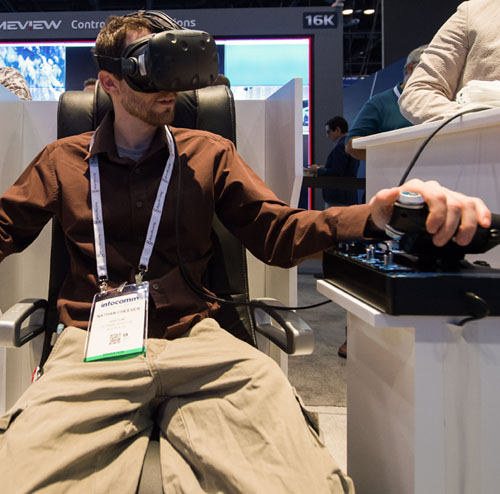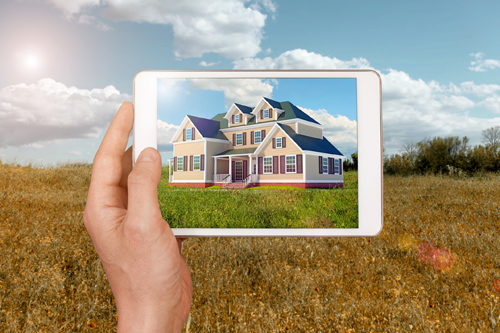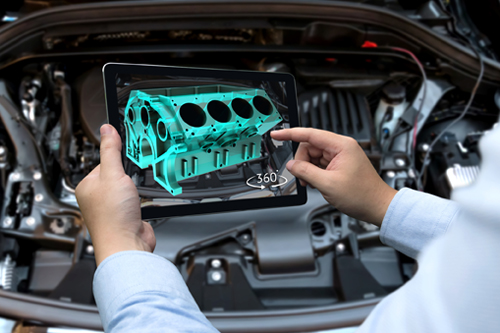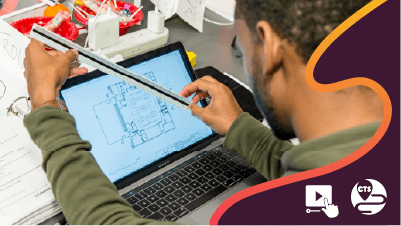Visualization’s Benefits and Applications Span Many Verticals
By Tim Kridel, Special to AVIXA
 Visualization describes a variety of innovative technologies that helps people immerse themselves in experiences and understand complex and even dangerous concepts. The category includes increasingly popular applications such as virtual reality (VR), augmented reality (AR), and cave automatic virtual environments (CAVE).
Visualization describes a variety of innovative technologies that helps people immerse themselves in experiences and understand complex and even dangerous concepts. The category includes increasingly popular applications such as virtual reality (VR), augmented reality (AR), and cave automatic virtual environments (CAVE).
Organizations in a wide variety of industries use visualization, but four stand out for their high adoption rates: health care, manufacturing, defense, and higher education. “From my research and interaction with different end users, those are the four biggies,” says Jim Angelillo, AVI-SPL Vice President of Business Development, Advanced Visualization.
In the consumer market, gaming and other entertainment are significant users of VR. Consumer usage of VR and AR affects the business market because those experiences educate people about how the technologies work.
Virtual Reality (VR)
VR can help to do work that is impractical, impossible, dangerous, or expensive for people to do any other way. Some examples:
- Training oil and gas workers on new equipment installed on wellheads in remote areas or underwater. Those are two places where it’s expensive — in terms of travel costs and productivity loss — to have those workers on site for days or weeks. With VR, they can learn a lot about that equipment, thus reducing or eliminating the need for additional on-site training. VR also makes it easier and safer to present users with unexpected scenarios to see how they respond.
- Observing the inside of a tornado, created artificially and virtually using atmospheric data collected from past storms. This kind of research would be impossible and deadly to do in real life. “You can take that [atmospheric] data and put it in a VR environment and into a large-scale environment like a CAVE,” Angelillo says. “You can see the dynamics inside.”
- Prototyping aircraft and vehicles. It’s expensive to build clay or fiberglass models to test a plane in a wind tunnel, or understand the instrument cluster’s ergonomics from a driver’s perspective. VR can eliminate the need for several physical iterations during a product development, saving millions of dollars and speeding time to market.
- Designing factories and other business facilities. As with aircraft and vehicles, it’s expensive and time-consuming to make changes after something is built. One oil and gas company used VR to do a walkthrough of a drilling platform before approving the design for construction. This uncovered several problems that were literally overlooked with just CAD renderings. “The piping was too low in one area, and they hit their head virtually,” Angelillo says. “It would have been a massive mistake had they gone into production.”
VR Redefining Home Design
 Some home builders are using VR to address longstanding industry problems such as buyer’s remorse and change orders. “Most people can’t read a floor plan, and they can’t visualize how the light will come into a room,” Tim Costello, founder and CEO of Builder Homesite, shared with the Washington Post. “They see the words kitchen and great room on a floor plan and the room dimensions, but they can’t visualize what that room will feel like. VR gives you a true sense of place, that you’ve actually walked around the room and can judge it because of the ability to see it from multiple angles. We think the use of VR will reshape and transform how new homes are designed, marketed and sold.”
Some home builders are using VR to address longstanding industry problems such as buyer’s remorse and change orders. “Most people can’t read a floor plan, and they can’t visualize how the light will come into a room,” Tim Costello, founder and CEO of Builder Homesite, shared with the Washington Post. “They see the words kitchen and great room on a floor plan and the room dimensions, but they can’t visualize what that room will feel like. VR gives you a true sense of place, that you’ve actually walked around the room and can judge it because of the ability to see it from multiple angles. We think the use of VR will reshape and transform how new homes are designed, marketed and sold.”
Pulte Group, the third-largest U.S. home builder, began using VR in 2016, including to presell condos in a building where a real-life model wouldn’t be available for another year. This example is noteworthy because it shows how a business can use VR to drum up enough interest to start driving revenue sooner than older alternatives could.
Pulte also is like automakers because they both use VR to reduce the expense of traditional models. “Model homes are here to stay because people still love to touch and see a home before they buy it, but maybe eventually we’ll build one model instead of three models and use virtual reality to showcase those other floor plans,” Valerie Dolenga, Pulte Director of Corporate Communications, told the Washington Post.
Augmented Reality (AR)
 AR mixes real and virtual reality. This emerging technology transforms the real-life environment into a digital interface by inserting virtual objects. The popular mobile game Pokemon Go is a widely used and understood application of AR. When experiencing AR, the user wears some sort of translucent head gear or eyepiece while looking at something in the real world. Examples follow:
AR mixes real and virtual reality. This emerging technology transforms the real-life environment into a digital interface by inserting virtual objects. The popular mobile game Pokemon Go is a widely used and understood application of AR. When experiencing AR, the user wears some sort of translucent head gear or eyepiece while looking at something in the real world. Examples follow:
- Building or troubleshooting complex equipment. An automotive mechanic traditionally would have a manual nearby while troubleshooting an engine or transmission. With an AR headset, he could look at the engine and have information about each part — such as the water pump — pop up in his field of view, with troubleshooting tips and assembly/disassembly instructions. The same concept could apply to HVAC systems, photocopiers, and aircraft, to name just a few possibilities.
- Training on equipment and processes. Like the previous example, employees would use AR to get information about the equipment and/or workflow as they’re using or performing it, instead of simply watching a video or a trainer. Although highly complex equipment and processes are obvious candidates, it’s a mistake to overlook simpler opportunities. For instance, a quick-serve restaurant chain could use AR to train managers and other employees on new equipment and workflows. Looking at a deep fryer, for example, could bring up information about how often the oil needs to be changed, the optimal temperature range, or how long a basket of chicken strips should be immersed.
Some businesses use both AR and VR because each one has capabilities and benefits that the other doesn’t. By combining them, those businesses achieve more benefits than they would by using just one technology.
Boeing uses VR to show trainees where every wiring run is in a particular model of aircraft. This makes training faster and easier, and it significantly reduces installation errors that are expensive and time-consuming to track down and fix. It also uses VR to ensure that more than just a handful of employees know how to do something.
“A lot of folks are trained in [aircraft] assembly, but some jobs are more 'tribal,' like a cargo door seal, which goes across the joint of the fuselage,” Paul Davies, Boeing associate technical fellow, said at a June 2017 conference. “It is a process that takes 50 individual steps and there's only a handful of people that know how to do this in the company. If they are sick or on vacation, we have delays."
Using Microsoft’s HoloLens solution, engineers can see a 3D model of all the components and have both pop-up instructions and voice-overs to guide them through the assembly process. Boeing says that so far, this approach should cut training time by 75 percent per person. "Initially we have someone [with experience in assembling cargo door seals] shadow the new person, and we do it in a classroom setting,” Davies said. “But we think it can all be done in two to three hours."
CAVE Comes Down in Cost Even as Experience Becomes More Lifelike
CAVE automatic virtual environments are immersive reality environments where projectors are directed to between three and six of the walls on a room-sized cube. A lifelike visual display is created by projectors positioned outside the CAVE and controlled by physical movement from a user inside the CAVE.
CAVE has benefited from Moore’s Law, which has steadily increased processing power while driving down its cost. This trend is why CAVE systems can use off-the-shelf PCs instead of more expensive, purpose-built computer hardware.
Another key trend is that CAVE systems’ resolution and frame rates have increased dramatically over the past decade, enabling a user experience that’s more lifelike and thus more practical for refining what’s being studied. Renault, for instance, has been using resolutions of up to 16K for more than three years. When a CAVE looks just like the inside of a car rather than low-res approximation of it, designers can make better decisions about what to tweak. This helps save money by, for example, reducing the need for traditional modeling techniques such as hand-built, clay prototypes.
These two trends are major reasons why companies such as Renault are implementing or expanding their use of CAVE. "We were aware of CAVE technology from the beginning, around 1990," says Andras Kemeny, Founder and Director of Renault’s Virtual Reality and Immersive Simulation Technologies Center. "We had talks with others in the field, including the Fraunhofer Institute in Stuttgart, where they had an early six-sided CAVE. At the time, the consensus at Renault was that the image quality and frame rate were not sufficient for our use."
Sometimes a CAVE system deployed for one or a few departments winds up being used by others, thus maximizing its ROI for the whole organization. For example, Renault’s CAVE initially was for vehicle architecture and interior ergonomic design. But usage quickly expanded to other applications, including vehicle styling, and interior and exterior lighting. “One thing that was very exciting for us was the fact that the CAVE was being embraced by various departments within Renault,” Kemeny says. “Ultimately, this is enabling us to build a better vehicle.” CAVE also enables Renault to save over €2 million annually.
Businesses and organizations are using visualization to understand and manipulate content that otherwise would be impractical or impossible for people to comprehend or work with in any other way – in other words, to gain a “big picture” view of things. These examples illustrate just some the opportunities for organizations in many different industries to use visualization technologies to make their operations more efficient, safer, and less expensive.





